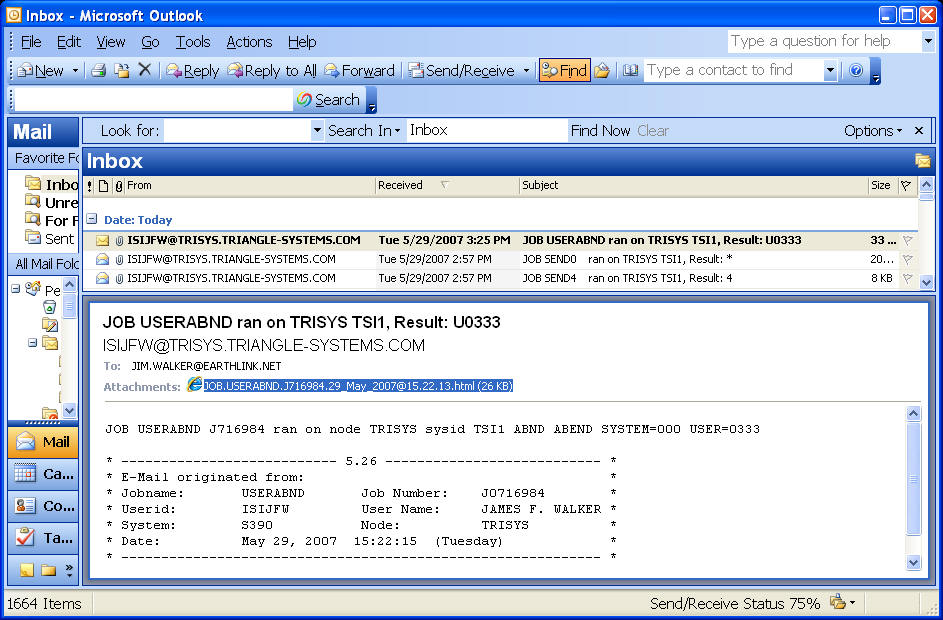
September 2007 Newsletter Updated October 2008
IOFTech Maintenance Release8G Newsletters Doc FAQ Contact Home |
Using IOF to Send Job Results via Email or FTPDid you ever need to be notified by email when a job fails? Did you ever want to send output from a batch job to someone via email or FTP? Now there is a simple way to satisfy these requirements with the IOFSEND facility. TopicsNote that this newsletter was updated in October 2008 to add significant new features including the ability to send job output via FTP. The new features require that optional fix T8C9064 be installed. This fix can be applied whether or not IOFSEND was previously installed on a system. |
IntroductionThere are many requirements to send JES2 job output to end users via email or FTP. These include:
IOF now provides a simple mechanism for using email to notify a user of a job's completion and to optionally attach reports from the job. The notification can be unconditional or dependent on the success or failure of the job. You can also select reports to be emailed directly from IOF display screens. The XMITIP Shareware Package developed by Lionel Dyck at Kaiser Permanente, Walnut Creek, CA provides a simple z/OS interface to email. XMITIP is a series of Rexx execs and is already installed on many z/OS sites. It can be downloaded from the Internet at no charge. The IOF SENDMAIL interface is a series of IOF Rexx execs that interface IOF to XMITIP. SENDMAIL provides the ability to send jobs, output groups or sysout data sets to a PC user via email. These execs are included in the IOF 8D clist library and can be installed on earlier releases with an optional fix. SENDMAIL is pre-installed on release 8D. The XMITIP PackageLionel Dyck, developer of XMITIP, describes it in the XMITIP Guide Introduction as follows:
If the XMITIP package is already installed at this site, the rest of this section can be skipped. If XMITIP is not installed, at least the basic parts must be installed before the IOF SENDMAIL interface can be used to send job output via email. XMITIP is not required to send output via FTP. XMITIP can be ordered from Lionel Dyck's web page at: http://www.lbdsoftware.com/xmitip.html This web site gives a good insight into the capabilities of XMITIP. It also provides documentation and installation hints. Note that XMITIP is a series of Rexx execs that interface to SMTP on the z/OS site. See the IBM manuals for information on installing SMTP if it is not already installed at your site. The IOF email applications use only a small part of the XMITIP package. In fact, IOF SENDMAIL uses only four Rexx execs provided in the XMITIP package. These execs are:
If you want to install only enough of XMITIP to support the IOF mail applications, these three execs are all that you need. Lional Dyck has permitted us to re-distribute these execs as an IOF optional fix so long as we give full credit to Lionel and Kaiser Permanente for the XMITIP development. Because XMITIP is continually improving and evolving, we encourage you to download the official version from the web site shown above and to install and use the full package. IOF Optional fix T8x9059 adds the first three XMITIP execs listed above to your IOF CLIST library. This fix should not be applied if you already run XMITIP at your site. If you subsequently install the full XMITIP package at your site, XMITIP, XMITIPCU and XMITLDAP should be removed from the IOF CLIST library.
IOFSEND Batch StepThe IOFSEND cataloged procedure shown below runs the IOFSNDME Rexx exec as a job step in batch TSO. It notifies a user by email that a job has run and optionally attaches the job's output. The IOFSEND cataloged procedure should be added to PROCLIB to simplify running the IOFSNDME exec in batch TSO. A sample cataloged procedure is shown below. The
procedure has 4 keyword parameters:
If the XMITIP execs are included in the IOF CLIST library, the SYSEXEC DD statement is not required . Several examples of using IOFSEND with parameters are shown below. The JCL shown is added as the last step of a JOB or STC.
IOFSEND provides a valuable communication tool to internet users when used with the JCL IF/THEN/ELSE statements or with the COND parameter. Simple JCL additions can cause users to be notified via email when a job runs, or just when it fails. A copy of the IOF Job Summary Display for the job will be attached to the email by default. The Log, JCL and Messages data sets can be added to the attachment by specifying DATA=JESDS. All sysout data sets can be added to the attachment by specifying DATA=ALL.
IOFSEND SYSIN ParametersIOFSEND parameters can also be specified in the optional SYSIN dataset. SYSIN parameters offer significant additional function:
Click here to see detailed specifications of SYSIN parameters. SENDMAIL IOF CommandThe SENDMAIL IOF command is used to send a JOB, Output Group or Sysout Data Set via XMITIP from an interactive IOF session. SENDMAIL is an ISPF application that prompts for SENDTO, CC, BCC and FROM addresses. SENDMAIL is both a primary command and a line command on the Job List Menu, Output Group Display, and IOF Job Summary. For simplicity, SENDMAIL is the only IOF command used on each of these panels. SENDMAIL can be abbreviated "SEN". SENDMAIL Option MenuThe SENDMAIL Option Menu is used to enter addresses and other parameters used by the SENDMAIL command. This option menu is displayed whenever the SENDMAIL command is entered.
The TO address must be specified. CC, BCC and FROM fields are optional. When FROM is not specified, the TSO userid and default XMITIP server name are used as the FROM email address. The default file name under which the output will be saved on the PC is displayed and can be changed on this menu. Jobs and groups are typically saved as an HTML file, and sysout data sets are saved as a TEXT file by default. Job List Menu and Output Group DisplaySENDMAIL can be used as both a primary command and a line command on the Job List Menu and Output Group Display.
Job SummarySENDMAIL can be used as both a primary command and a line command on the IOF Job Summary.
EMail FormatIOFSNDME and the SENDMAIL command produce very similar email formats. The SUBJECT line describes the output that is included in the mail. The message text provides slightly more information about the job, group or sysout data set. A copy of the IOF Job Summary Panel and optionally sysout data sets are attached to the email. The email client user is notified that a job has completed without opening the email. More detail can be seen by opening the mail. Finally, the full IOF Job Summary panel can be displayed to tell more about how the job ran by selecting and/or saving the attachment. A typical Outlook panel displaying jobs is shown below. Note that the SUBJECT line shows the jobname, where it ran, and the job result. Result of 0 means that all job steps ran with return code 0. Result "*" means that at least one jobstep did not run. System and user abends are displayed as Sccc and Ucccc. The message for the first job, which had user abend 333, is shown below with additional information.
|
Click here to see the message attachment that includes the job packaged as zipped HTML.
Installation InstructionsThe IOF email application is packaged as an optional fix that is included in for all IOF release 8 cumulative fix (CFX) files. This application is not available for IOF release 7. The fix number is T8x9064, where "x" is the release 8 version. For example, T8C9064 is the fix for release 8C. T8x9064 supersedes fixes T8x9058 and T8x9060, and can be applied whether or not these fixes were previously applied. Click here to download the cumulative fix file for your release. Follow the instructions on the maintenance web page to download the appropriate CUMFIX file, receive it and apply the optional fix. To display optional fixes you must enter OPT when the maintenance dialog displays available fixes. The maintenance adds the members listed below to your IOF libraries. No other changes to IOF are made. You will have to run the M13GEN job to install the SENDMAIL command.
If you are not already running XMITIP at the site, you can either order it from Lionel Dyck or apply optional fix T8x9059. (x is your release 8 version of IOF). This fix copies XMITIP, XMITIPCU and XMITLDAP to your IOF clist library. Note that these members should be removed from the IOF clist library if you subsequently install the full XMITIP shareware package. After applying fix T8x9064 (and T8x9059 if required) the SENDMAIL interactive command and the IOFSNDME batch TSO command can be used to send jobs, groups or sysout data sets via email or FTP. Look at the XMITIP command output to diagnose problems with the transmission. The SYSTSPRT DD statement can be added to the IOFSEND cataloged procedure to provide XMITIP diagnostic information from batch TSO steps.
|
Email IOFTech@Triangle-Systems.Com
IOFTech Maintenance Release8G Newsletters Doc FAQ Contact Home
